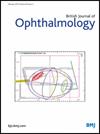Comparative diagnostic performance of six imaging modalities for detecting macular atrophy in neovascular age-related macular degeneration
IF 3.5
2区 医学
Q1 OPHTHALMOLOGY
引用次数: 0
Abstract
Purpose To evaluate the diagnostic accuracy of six imaging modalities—colour fundus photography (CFP), multicolour imaging (MC), blue autofluorescence (BAF), green autofluorescence (GAF), near-infrared reflectance (NIR) and structural optical coherence tomography (OCT)—for detecting macular atrophy (MA) in patients with previously treated neovascular age-related macular degeneration (AMD). Methods This retrospective cohort study included 113 eyes from patients treated with anti-vascular endothelial growth factor for at least 1 year. All eyes underwent six imaging modalities during the same visit. MA was identified by a senior retinal specialist using multimodal criteria and served as the diagnostic reference (ie, gold standard). Sensitivity and specificity of each imaging modality were calculated relative to this reference. Two masked graders independently assessed images using modality-specific definitions of MA. Discrepancies were resolved by consensus. Sensitivity, specificity, positive predictive value, negative predictive value and inter-reader agreement were calculated for each modality. Results MA was present in 46.9% of eyes based on multimodal imaging. Structural OCT detected MA in 43.4% of cases, followed by GAF (36.3%), BAF and NIR (35.4% each), MC (33.6%) and CFP (30.1%). Structural OCT demonstrated the highest diagnostic accuracy, with 92.4% sensitivity and 96.7% specificity. Other modalities showed moderate sensitivity (64.1–77.4%) and specificity (75.0–88.3%). Inter-reader agreement was moderate for BAF (κ=0.46) and lower for the remaining modalities, lowest for CFP (κ=0.18). Conclusions Structural OCT offers the highest accuracy and reliability for detecting MA in neovascular AMD, supporting its use in both clinical practice and research. Other modalities may supplement OCT when needed, but CFP alone is limited. Data are available upon reasonable request. Data are available upon reasonable request to the corresponding author.新血管性年龄相关性黄斑变性中黄斑萎缩的六种成像方式的比较诊断性能
目的评价彩色眼底摄影(CFP)、多色成像(MC)、蓝色自身荧光(BAF)、绿色自身荧光(GAF)、近红外反射(NIR)和结构光学相干断层扫描(OCT)六种成像方式对既往治疗过的新生血管性年龄相关性黄斑变性(AMD)患者黄斑萎缩(MA)的诊断准确性。方法回顾性队列研究纳入113只眼,患者接受抗血管内皮生长因子治疗至少1年。所有的眼睛在同一次访问期间接受了六种成像方式。MA由一位资深视网膜专家使用多模态标准确定,并作为诊断参考(即金标准)。相对于该参考计算每种成像方式的灵敏度和特异性。两名蒙面评分者使用模态特定的MA定义独立评估图像。分歧经协商一致解决。计算每种模式的敏感性、特异性、阳性预测值、阴性预测值和读者间一致性。结果多模态成像显示,46.9%的眼存在MA。结构OCT检出MA的占43.4%,其次是GAF(36.3%)、BAF和NIR(各占35.4%)、MC(33.6%)和CFP(30.1%)。结构OCT诊断准确率最高,敏感性为92.4%,特异性为96.7%。其他方式显示中等敏感性(64.1-77.4%)和特异性(75.0-88.3%)。BAF的读者间一致性中等(κ=0.46),其余模式的一致性较低,CFP最低(κ=0.18)。结论结构OCT对新血管性AMD的MA检测具有较高的准确性和可靠性,支持其在临床实践和研究中的应用。在需要的时候,其他的治疗方式也可以作为OCT的补充,但是单独使用CFP是有限的。如有合理要求,可提供资料。如果向通讯作者提出合理要求,可以获得数据。
本文章由计算机程序翻译,如有差异,请以英文原文为准。
求助全文
约1分钟内获得全文
求助全文
来源期刊
CiteScore
10.30
自引率
2.40%
发文量
213
审稿时长
3-6 weeks
期刊介绍:
The British Journal of Ophthalmology (BJO) is an international peer-reviewed journal for ophthalmologists and visual science specialists. BJO publishes clinical investigations, clinical observations, and clinically relevant laboratory investigations related to ophthalmology. It also provides major reviews and also publishes manuscripts covering regional issues in a global context.

 求助内容:
求助内容: 应助结果提醒方式:
应助结果提醒方式:


